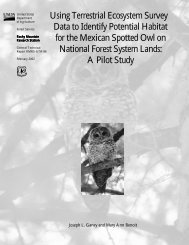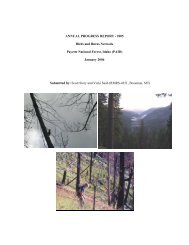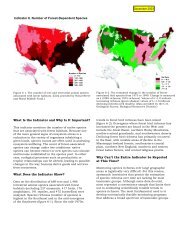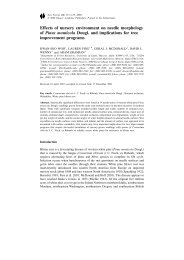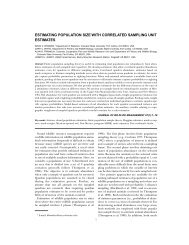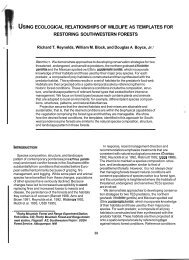Threats to and Sustainability of Ecosystems for Freshwater Mollusks
Threats to and Sustainability of Ecosystems for Freshwater Mollusks
Threats to and Sustainability of Ecosystems for Freshwater Mollusks
You also want an ePaper? Increase the reach of your titles
YUMPU automatically turns print PDFs into web optimized ePapers that Google loves.
seasonal <strong>and</strong> on a scale <strong>of</strong> a few <strong>to</strong> an estimated maximum <strong>of</strong><br />
100 meters (Green et al. 1985). There<strong>for</strong>e, unlike many stream<br />
organisms such as fish <strong>and</strong> aquatic insects (Townsend 1989),<br />
adult mussels have no refugia from disturbance events in<br />
streams. In addition, their filter-feeding habits make them<br />
especially vulnerable <strong>to</strong> sedimentation <strong>and</strong> chemical pollution<br />
events.<br />
<strong>Threats</strong> <strong>and</strong> Causes <strong>of</strong> Decline<br />
Species associations, species richness, metapopulation<br />
structure, <strong>and</strong> densities <strong>and</strong> population size structure <strong>of</strong><br />
individual species are all potentially impacted by <strong>for</strong>est<br />
management practices. In addition, any effects on fish<br />
communities may ultimately affect mussels as well. Watters<br />
(1992) recently found high correlation between fish distribution<br />
<strong>and</strong> diversity <strong>and</strong> mussel distnbution <strong>and</strong> diversity.<br />
One major cause <strong>of</strong> mussel declines has been the<br />
fragmentation <strong>of</strong> river drainages through impoundments,<br />
channelization <strong>and</strong> other activities, such as timber-harvesting,<br />
which alter flow <strong>and</strong> sedimentation patterns. Declines in mussel<br />
species <strong>for</strong> various river drainages <strong>and</strong> the disturbance fac<strong>to</strong>r<br />
associated with these declines are shown in Table 2.<br />
TImber harvesting operations can have significant effects on<br />
both stream water quantity <strong>and</strong> quality. The influence <strong>of</strong><br />
catchment vegetation on stream discharge is dependent on a<br />
large number <strong>of</strong> variables, many <strong>of</strong> which are site-specific.<br />
However, in general, removal <strong>of</strong> <strong>for</strong>est vegetation increases<br />
stream run<strong>of</strong>f (Campbell <strong>and</strong> Doeg 1989). Increased flows have<br />
the potential <strong>to</strong> alter the distnbution <strong>of</strong> sediment through scour,<br />
flushing, <strong>and</strong> deposition <strong>of</strong> newly eroded materials from the<br />
banks. Increased flows also have the potential <strong>to</strong> activate the<br />
bed. Bedload movement will wreak havoc on the survival <strong>of</strong><br />
many mussels, particularly juveniles (Young <strong>and</strong> Williams<br />
1983). Erosion caused by increased flows at one location results<br />
in deposition <strong>of</strong> this material further downstream. This "zone<br />
Drainage<br />
Upper Tennessee River<br />
Middle <strong>and</strong> Lower Tennessee R.<br />
sedimentation<br />
Tombigbee River at Epes, AL<br />
S<strong>to</strong>nes River, TN<br />
Upper S<strong>to</strong>nes River, TN<br />
Sugar Creek, IN<br />
Illinois River, IL<br />
Kankakee River, IL<br />
Kaskaskia River, IL<br />
Vermillion River, IL<br />
Embarras River, IL<br />
Little Wabash River, IL<br />
<strong>of</strong> aggradation" results in an increased width/depth ratio <strong>of</strong> that<br />
portion <strong>of</strong> the channel. As width/depth ratios increase the<br />
potential <strong>for</strong> bedload transport also increases. Thus, increased<br />
flows cause habitat loss through both sediment deposition <strong>and</strong><br />
increased bed mobility. In the long term, higher base flow levels<br />
<strong>and</strong> shorter periods between peak flood periods will decrease<br />
habitat complexity by preventing the <strong>for</strong>mation <strong>of</strong> isl<strong>and</strong>s,<br />
establishment <strong>of</strong>macrophyte beds, etc. (Frissell 1986). Stabilized<br />
sediments, s<strong>and</strong> bars, <strong>and</strong> low flow areas, are all preferred<br />
unionid habitats (Hartfield <strong>and</strong> Ebert 1986, Payne <strong>and</strong> Miller<br />
1989, Stem 1983, Way et al. 1990). It is around these" complex"<br />
areas that most mussel beds, <strong>and</strong> indeed the highest diversity <strong>of</strong><br />
stream fauna, are found.<br />
Road-building activities <strong>and</strong> low water crossings associated<br />
with logging can lead <strong>to</strong> the development <strong>of</strong> "headcuts", or<br />
migrating knickpoints in the channel remote from areas <strong>of</strong> actual<br />
modification. Headcuts result in severe bank erosion, channel<br />
widening, <strong>and</strong> depth reduction <strong>and</strong> can have devastating effects<br />
on the mollusc fauna (Hart 1993).<br />
Stream organisms, including mussels, have evolved in rivers<br />
that experience seasonal low-flow <strong>and</strong> high-flow periods<br />
(Meador <strong>and</strong> Matthews 1992). Fluctuating flows, especially if<br />
there will be lower flows <strong>for</strong> long periods <strong>of</strong> time, will result<br />
in the str<strong>and</strong>ing <strong>of</strong> many mussels. Unlike fish species which can<br />
move rapidly in <strong>and</strong> out <strong>of</strong> microhabitats with changes in water<br />
levels, mussels move very slowly <strong>and</strong> are unable <strong>to</strong> respond <strong>to</strong><br />
sudden drawdowns. Even if str<strong>and</strong>ing doesn't actually kill a<br />
mussel, desiccation <strong>and</strong> thermal extremes will cause<br />
physiological stress <strong>and</strong> may reduce reproductive potential<br />
(McMahon 1991).<br />
Fluctuating flows also mean that transport <strong>of</strong> particulates will<br />
vary. Depending on the flow schedule <strong>and</strong> the materials normally<br />
transported in the water column, there is the potential <strong>for</strong> loss<br />
<strong>of</strong> organics which are the food base <strong>for</strong> mussels.<br />
Flow alteration not only has the potential <strong>to</strong> pr<strong>of</strong>oundly affect<br />
the stream fauna, but riparian fauna as well. Flood waters that<br />
normally recharge soils <strong>and</strong> aquifers may be rapidly exported<br />
Table 2. - Reported loss <strong>of</strong> unionid mussel species from rivers <strong>and</strong> fac<strong>to</strong>rs contributing <strong>to</strong> the losses.<br />
% Species Lost<br />
36%<br />
13%<br />
68%<br />
40%<br />
25%<br />
20%<br />
51%<br />
25%<br />
38%<br />
40%<br />
39%<br />
24%<br />
Major Fac<strong>to</strong>r in Decline<br />
Impoundments, sedimentation<br />
Impoundments, channelization,<br />
Impoundment<br />
Impoundment<br />
Gravel dredging, water quality<br />
Impoundments, channelization,<br />
sedimentation<br />
Siltation<br />
Siltation<br />
(80% reduction in numbers <strong>of</strong> individuals)<br />
73<br />
Source<br />
Starnes <strong>and</strong> Bogan (1988)<br />
Starnes <strong>and</strong> Bogan (1988)<br />
Vllilliams et al. (1992)<br />
Schmidt et al. (1989)<br />
Schmidt et al. (1989)<br />
Harmon (1992)<br />
Starret (1971)<br />
Suloway (1981)<br />
Suloway et al. (1981)<br />
Cummings (1991)<br />
Cummings (1991)<br />
Cummings (1991)



